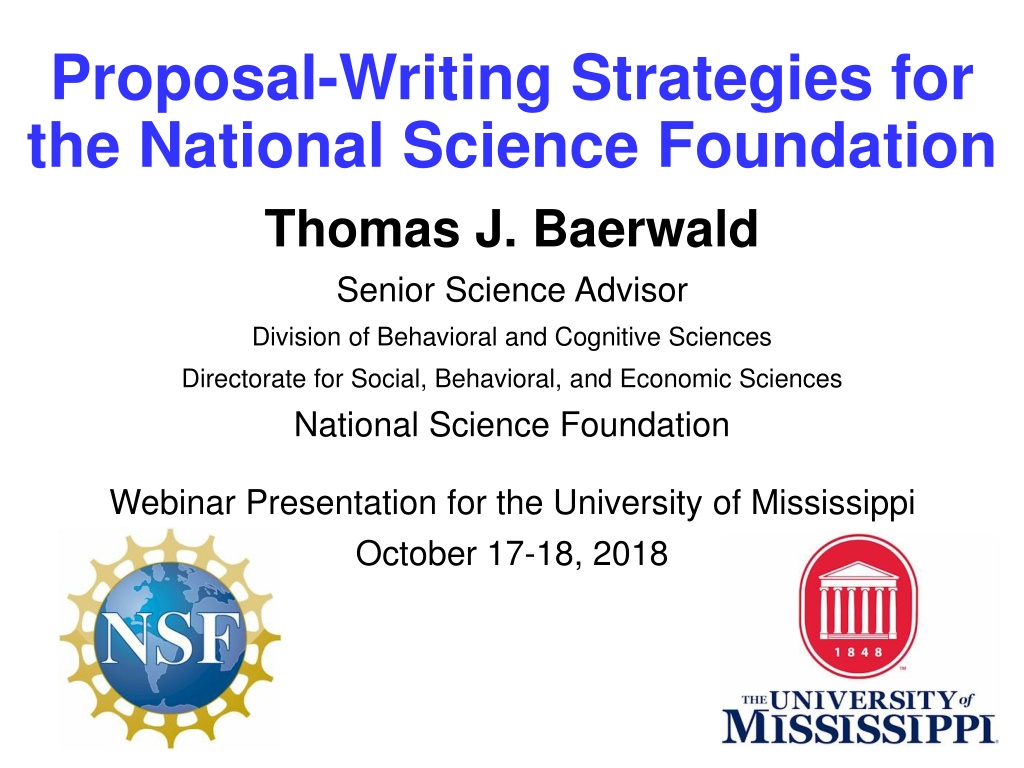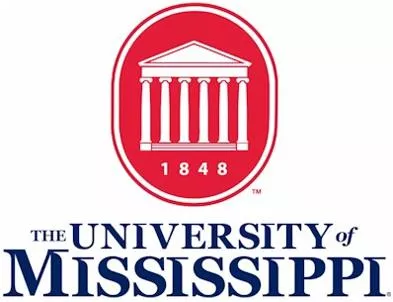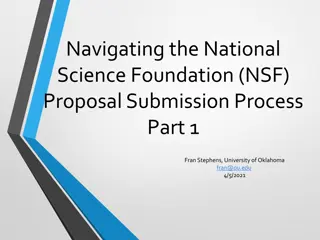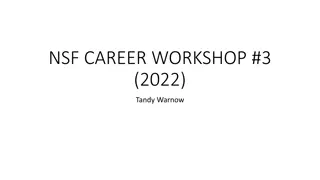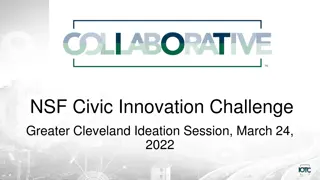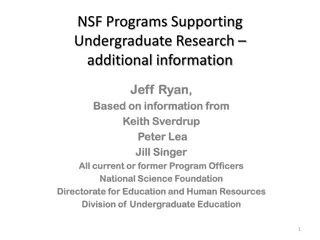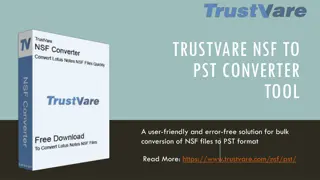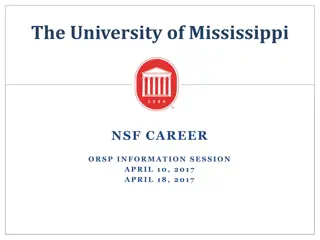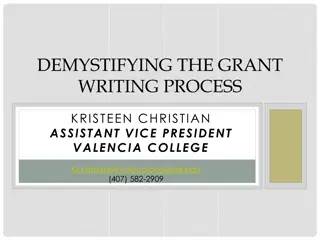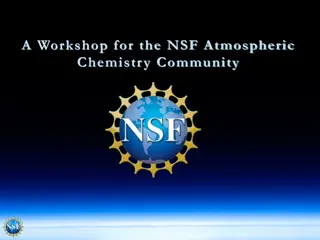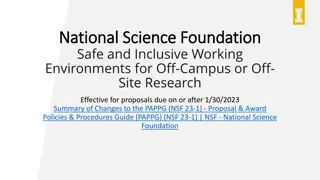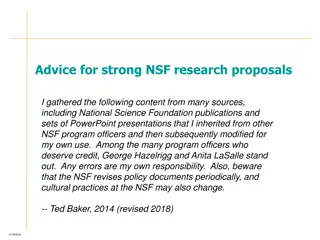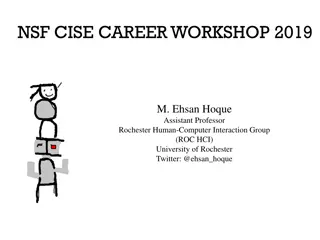Effective NSF Proposal Writing Strategies
Crafting successful proposals for the National Science Foundation requires a strategic approach and understanding of their organizational structure. Learn key insights and strategies from a senior NSF science advisor to enhance your grant applications. Discover the core principles guiding NSF funding decisions and how to align your projects with their goals for maximum impact.
Download Presentation

Please find below an Image/Link to download the presentation.
The content on the website is provided AS IS for your information and personal use only. It may not be sold, licensed, or shared on other websites without obtaining consent from the author.If you encounter any issues during the download, it is possible that the publisher has removed the file from their server.
You are allowed to download the files provided on this website for personal or commercial use, subject to the condition that they are used lawfully. All files are the property of their respective owners.
The content on the website is provided AS IS for your information and personal use only. It may not be sold, licensed, or shared on other websites without obtaining consent from the author.
E N D
Presentation Transcript
Proposal-Writing Strategies for the National Science Foundation Thomas J. Baerwald Senior Science Advisor Division of Behavioral and Cognitive Sciences Directorate for Social, Behavioral, and Economic Sciences National Science Foundation Webinar Presentation for the University of Mississippi October 17-18, 2018
NSF is a Government Agency, But We're Staffed by Real People Who Take Public Service Seriously NSF's new headquarters building is at 2415 Eisenhower Ave, Alexandria, Virginia (just inside the beltway)
NSF is an Independent Agency of the Executive Branch of the U.S. Government President Science Advisor: Office of Science and Technology Policy Office of Other Boards, Councils Management and Budget Cabinet Ag DOC DOD DOE Ed HHS HUD DOI DOJ DHS DOL DOS Treas DVA DOT Independent Agencies Smithsonian Inst Nuclear Reg Comm NSF NASA EPA Others
NSF is Organized into Seven Directorates National Science Board Director Deputy Director Staff Offices Inspector General Computer and Information Science and Engineering Biological Sciences Engineering Mathematics and Physical Sciences Geosciences Education and Human Resources Budget, Finance, and Award Management Information Resource Management Social, Behavioral, and Economic Sciences
Directorates Are Divided into Divisions; Divisions Are Divided into Programs or Sections Social Behavioral, and Economic Sciences National Center for Science and Engineering Statistics SBE Behavioral and Cognitive Sciences Social and Economic Sciences Multidisciplinary Activities Economics Geography and Spatial Sciences Decision, Risk, and Management Sciences Methodology, Measurement, and Statistics Anthropology Programs Sociology Psychology and Linguistics Programs Political Science Law and Social Science Science, Technology, and Society
Understand the Core Principles NSF seeks to invest its funds in projects that best advance its goals. NSF uses an organized process to determine how funds should be allocated. Your job is to write a proposal that will make a strong and compelling case for helping NSF meet its goals.
NSF's First Strategic Goal Expand knowledge in science, engineering, and learning Advance knowledge through investments in ideas, people, and infrastructure Advance the practice of research - NSF Strategic Plan for 2018-2022
NSF's Second Strategic Goal Advance the capability of the nation to meet current and future challenges Support research and promote partnerships to accelerate innovation and to provide new capabilities to meet pressing societal needs Foster the growth of a more capable and diverse research workforce and advance the scientific and innovation skills of the nation - NSF Strategic Plan for 2018-2022
NSF Funds BASIC SCIENCE RESEARCH! Basic research is situated in a theoretical framework Basic research focuses on one or a few specific questions rooted in that framework Basic research uses scientifically sound methods to explore viable answers to those questions Basic research contributes generalizable knowledge and advances broadertheory
As a result... Basic scientific research contributes to general understanding It s research that s well grounded in a general theoretical framework or that generates development of new frameworks It s research that s valuable even if we don t care about its specific findings or applications It s research that often increases our knowledge of how we expand our knowledge
Basic "vs." Applied Research It's not "either/or" Basic research results often have great direct and indirect utility and applicability But at its core, basic research is first and foremost about broader theoretical development, not the focused application of specific research results Basic research is not WISCy (wallowing in a specific case)
How Do You Gain Access to Some of NSF s Funds? Submit a proposal to compete in standing program competitions for unsolicited proposals Submit a proposal for a special competition Topics often cross-cut programs, divisions, and directorates
In Addition to Its Standing Programs, NSF Has Many Special Funding Opportunities INFEWS RAPID EAGER EaSM RUI/ROA CSSI Check the NSF Web site for more information or contact relevant program officers
NSF's "Big Ideas" Research ideas Harnessing the Data Revolution The Future of Work at the Human-Technology Frontier Navigating the New Arctic Windows on the Universe: Multi-Messenger Astrophysics The Quantum Leap: Leading the Next Quantum Revolution Understanding the Rules of Life Process ideas Mid-Scale Research Infrastructure Growing Convergence Research NSF INCLUDES NSF 2050: Integrative Foundational Fund
To Which Programs or Competitions Should You Apply? Remember that NSF supports basic research that yields significant new findings that have wide- ranging theoretical benefit Identify the communities that you think will be most interested in your findings Identify the journals where you expect to publish your findings -- the readers likely will be in the communities for which your research will have greatest value "Map" those communities against NSF programs and competitions Send a prospectus to the program officers of the programs/competitions you think may be interested
What Should Be in a Prospectus? A paragraph or so about each of the following: Theoretical foundations of the project Core questions on which you'll focus Methods to be used to assess answers to questions Expected intellectual merit and broader impacts Nature of the scope of the project and who will be involved Limit the prospectus to 1 or 2 pages Send by e-mail along with additional questions you may have -- send a group message to all program officers of all programs you think may have interest Send the prospectus well in advance of proposal due dates
Explore Co-Review Possibilities NSF rules prohibit submitting essentially the same proposal to multiple programs at once Regular programs often co-review proposals with each other when projects attempt to draw on and contribute to basic knowledge that bridges multiple communities and programs NSF programs seek to ensure that co-review offers "double opportunity," not "double jeopardy It's best to sound programs out regarding co-review well in advance of proposal-submission due dates Knowledge of the programs that will review a proposal helps you best write to the multiple or overlapping communities of interest
Obtaining Funding Is Like Entering a Diving Competition Your chances of success are best if you: Learn the rules of the competition Learn which entries receive the highest marks Learn how the competition is organized Hone your skills and correct your defects Take care to do your best Realize that how you place will also depend on how well other competitors do
How Do You Learn the Rules? Check websites of the funding organization Access and read relevant documents At NSF, such documents include PAPPG and competition-specific solicitations Determine whether pre-submission contact with organization staff members is permitted or encouraged If so, contact relevant staffers with a prospectus and/or questions if needed, but make sure you've already "done your homework"
How Do You Earn the Highest Marks? Identify the funder's goals and review criteria used to make funding decisions Do all that you can to ensure that your proposed work will help meet the funder's goals and match up positively with the review criteria Be explicit in showing how your work will match up with what the funder wants to result But don't overreach. If your work won't accomplish what the funder wants, look elsewhere
How Do You Learn How a Competition Is Organized? Get relevant information Check the website Read the solicitation and other relevant documents Ask informed questions of the organization's program officers Try to understand who will review and make decisions about your proposal, and write the proposal to speak directly to them within the framework of the review criteria
How Do You Hone Skills, Correct Defects, and Do Your Best? Give yourself lots of time Do preliminary work months before the deadline Draft the proposal and ask others to read and comment on it at least four weeks before the deadline Revisit the proposal after you've had time away -- two weeks before the deadline Comply completely with proposal-preparation requirements. If you're uncertain, ask well before the deadline Get feedback from colleagues and friends Ask them to be totally open and honest
What Does the Fact You're Competing for Funds Mean? Others are trying to make the case for their work You have no control over what they do You can do everything right, attain a personal best, and still finish out of the money You control your own proposal, so make it as strong and compelling as possible Don't interpret a decline as evidence you can't be funded in future versions of this competition or in other competitions
Strategies for Preparing Proposals for NSF Remember that NSF focuses on support for basic scientific research Funding occurs through competitions with proposals subject to merit evaluation based on peer review Allow plenty of time to learn about competitions, draft and revised proposals, and submit proposals before deadlines
What Is the Crucial Ratio for a Program Officer? $ "Bang for the Buck!"
What Kind of "Bang" Is an NSF Program Officer Looking For? Significant contributions to general scientific understandings. Enhancements of theoretical understandings in addition to any expansion of specific knowledge, especially potentially transformative advances. Broader impacts, such as enhanced education, greater diversity, improved infrastructure or methods, and beneficial applications. Dissemination of results, especially in refereed, widely disseminated publications.
What Is the Crucial Ratio for a Program Officer? Likelihood of Significant Contributions to General Scientific Understanding and Positive Broader Impacts $ "Potential Bang for the Buck!"
At NSF, Decisions Will Be Based on the NSF Merit Review Criteria NSF asks reviewers to comment on two major criteria: Intellectual merit Broader impacts https://www.nsf.gov/pubs/policydocs/pappg18_1/pappg_3.jsp#IIIA
Merit Review Principles NSF projects should be of the highest quality and have the potential to advance, if not transform, the frontiers of knowledge NSF projects should contribute more broadly to achieving societal goals Meaningful assessment and evaluation of NSF-funded projects should be based on appropriate metrics The principles should be considered when preparing and reviewing proposals
Merit Review Criteria Intellectual Merit: The Intellectual Merit criterion encompasses the potential to advance knowledge Broader Impacts. The Broader Impacts criterion encompasses the potential to benefit society and contribute to the achievement of specific, desired societal outcomes
Examples of Broader Impacts Full participation of women, persons with disabilities, and underrepresented minorities in science, technology, engineering, and mathematics (STEM) Development of a diverse, globally competitive STEM workforce Improved STEM education and educator development at any level Increased public scientific literacy and public engagement with science and technology Improved well-being of individuals in society Increased partnerships among academia, industry, and others Improved national security Increased economic competitiveness of the United States Enhanced infrastructure for research and education
Elements for Consideration for Both IM and BI Criteria - 1 Criteria related to capabilities to conduct a project successfully: How well qualified is the individual, team, or organization to conduct the proposed activities? Are there adequate resources available to the PI (either at the home organization or through collaborations) to carry out the proposed activities?
Elements for Consideration for Both IM and BI Criteria - 2 Criterion related to how a project will be conducted: Is the plan for carrying out the proposed activities well-reasoned, well-organized, and based on a sound rationale? Does the plan incorporate a mechanism to assess success?
Elements for Consideration for Both IM and BI Criteria - 3 Criteria related to the potential contributions of a project: What is the potential for the proposed activity to: Advance knowledge and understanding within its own field or across different fields (IM)? Benefit society or advance desired societal outcomes (BI)? To what extent do the proposed activities suggest and explore creative, original, or potentially transformative concepts?
NSF Merit Review Criteria Summary Overarching principles Highest quality Contribute to society Meaningful assessment and evaluation Merit review criteria: Intellectual merit Broader impacts Elements considered for both criteria: Capabilities Conduct Potential contributions Address program-specific/competition-specific criteria (if applicable)
Whats Included in a Competitive NSF Research Proposal? An explanation of the theoretical framework within which the research question is set Specification of the methods to be used to answer the question Elaboration of how expected results will enhance the broader theoretical framework and have positive broader impacts Biographical information about investigators A data-management plan and other required materials A budget with justification of expenses Other required materials
When You Prepare a Proposal, Think Like Those Who Will Evaluate It External reviewers They tend to be specialists; relevant theory and technical details matter Advisory panel members They largely consist of generalists; so broader significance matters Program officers We re the investors, seeking "big bangs for our bucks"
Additional Things to Consider When Preparing an NSF Proposal Keep the broader intellectual context clear Explore broader theory and relevant literature Ground focal questions in a theoretical framework Specify scientifically sound research plan Discuss how expected results will contribute to enhanced theory and broader impacts Don't start with and maintain focus on the specific case
What Expenses Should Be Listed in a Budget? For every possible expenditure, ask yourself: Is this expenditure necessary at this level to complete the project? -- or -- Would the research be diminished substantially if this expenditure is not made or is significantly reduced? If you answer Yes to these questions, include the expenditure in the budget If you answer No, leave the item out or reduce it to reasonable levels Be cognizant of overall funding limits for awards and for a program
Take Data Management Seriously The types of data, samples, physical collections, software, curriculum materials, and other materials to be produced in the course of the project The standards to be used for data and metadata format and content (where existing standards are absent or deemed inadequate, this should be documented along with any proposed solutions or remedies) Policies for access and sharing including provisions for appropriate protection of privacy, confidentiality, security, intellectual property, or other rights or requirements Policies and provisions for re-use, re-distribution, and the production of derivatives Plans for archiving data, samples, and other research products, and for preservation of access to them Provide long-term access from institutionally managed databases for all data and other products that can be made accessible to others Note that accessible data constitutes a broader impact
What If Your Proposal Is Declined? Pause a while to let the pain subside somewhat Evaluate the reviews If criticisms focus on correctable points, revise and resubmit the proposal If criticisms are more general, consider other funding sources or other lines of inquiry If you have questions or want additional information, contact the program officer
Speaking of Time A Suggested Timeline for Developing Proposals 3 months before the deadline 1 month before the deadline 2 weeks before the deadline 1 week before the deadline Develop prospectus for proposal and share it with colleagues as well as relevant agency program officers. Complete what you think is a very solid first draft of the entire proposal. Share it with colleagues and ask for honest, constructive advice. Use comments from colleagues to revise the proposal one or two more times. Forward the proposal to your sponsored projects office so that they can complete their work and submit the proposal a day or two before the deadline Politely ask the managing program officer when a decision might be made about your proposal (if you haven t heard about its status already). 5 months after the deadline
Above All Else, Be Persistent! Remember the words of Christopher Morley: "Big shots are just little shots who keep shooting!"
The NSF Staff Is at Your Service It s not quite that easy, but we will provide whatever info we can to help you make the strongest possible case for your project. E-mail or call!
Contact Information Thomas Baerwald tbaerwal@nsf.gov 703-292-7301 Directorate for Social, Behavioral, and Economic Sciences National Science Foundation 2415 Eisenhower Ave Alexandria VA 22314 U.S.A. Consult the NSF web site to identify program officers for other programs or competitions.
